From classics like Charlotte’s Web to contemporary favorites like Because of Winn-Dixie, some of the best pieces of literature for children and young adults entwine the lives of humans and animals. The recently published books in this week’s column feature animals as compelling characters and companions to humans.
Ages 4–8
Princess Cora and the Crocodile. Laura Amy Schlitz. Ill. Brian Floca. 2017. Candlewick.
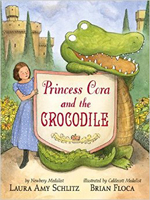 When a princess struggles to find her voice and exert her independence, the most unexpected of characters comes to her rescue. In this slapstick, topsy-turvy fairy tale, an overworked (and over-bathed) princess wants a pet to break up the daily monotony of life as the queen-in-training. When her mother, father, and nanny all say no to a dog, she pens a letter to her godmother. A crocodile unexpectedly arrives and hijinks ensue as he takes her place for the day. Cora discovers what she’s been missing as well as the strength to stand up for what she wants. Young readers will laugh at the crocodile’s actions (which, in true crocodile fashion, involve some biting) and the happily-ever-after ending for both the princess and the cream puff-loving crocodile—and, perhaps, also learn something about the value of speaking their mind.
When a princess struggles to find her voice and exert her independence, the most unexpected of characters comes to her rescue. In this slapstick, topsy-turvy fairy tale, an overworked (and over-bathed) princess wants a pet to break up the daily monotony of life as the queen-in-training. When her mother, father, and nanny all say no to a dog, she pens a letter to her godmother. A crocodile unexpectedly arrives and hijinks ensue as he takes her place for the day. Cora discovers what she’s been missing as well as the strength to stand up for what she wants. Young readers will laugh at the crocodile’s actions (which, in true crocodile fashion, involve some biting) and the happily-ever-after ending for both the princess and the cream puff-loving crocodile—and, perhaps, also learn something about the value of speaking their mind.
—LK
Shawn Loves Sharks. Curtis Manley. Ill. Tracy Subisak. 2017. Roaring Brook.
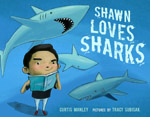 Shawn has a shark lamp, a shark alarm clock, a shark snow globe, and even a shark hoodie. When his teacher announces that each student will be drawing the name of a predator to research for a class project, Shawn is desperate to pick the great white shark. Unfortunately, his classmate Stacy picks the great white shark and Shawn gets the leopard seal. Shawn is devastated and tries to convince Stacy to switch with him. The two go back and forth arguing about their predators, and Shawn soon discovers that he might love seals too. The story is told through traditional narrative as well as speech bubbles and text embedded in the illustrations. Readers will enjoy the dynamics between Shawn and Stacy and the playful illustrations, including the various costumes Shawn’s cat wears throughout the book.
Shawn has a shark lamp, a shark alarm clock, a shark snow globe, and even a shark hoodie. When his teacher announces that each student will be drawing the name of a predator to research for a class project, Shawn is desperate to pick the great white shark. Unfortunately, his classmate Stacy picks the great white shark and Shawn gets the leopard seal. Shawn is devastated and tries to convince Stacy to switch with him. The two go back and forth arguing about their predators, and Shawn soon discovers that he might love seals too. The story is told through traditional narrative as well as speech bubbles and text embedded in the illustrations. Readers will enjoy the dynamics between Shawn and Stacy and the playful illustrations, including the various costumes Shawn’s cat wears throughout the book.
—LC
If Sharks Disappeared. Lily Williams. 2017. Roaring Brook.
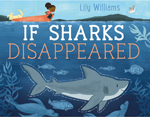 In this informational book, a young girl helps tell the story of what would happen to the ocean’s ecosystem if sharks disappeared. The book functions well as both picture book and a nonfiction book, due to its interactive tone and cartoon-style illustrations. A vertical gatefold with the narrator fishing at the top dramatically captures the depth of the ocean as blue water turns darker. The end matter includes a glossary, a note on the endangered status of sharks, a “How You Can Help Save Sharks” list, an author’s note which encourages readers to do more research, a bibliography, and Internet resources.
In this informational book, a young girl helps tell the story of what would happen to the ocean’s ecosystem if sharks disappeared. The book functions well as both picture book and a nonfiction book, due to its interactive tone and cartoon-style illustrations. A vertical gatefold with the narrator fishing at the top dramatically captures the depth of the ocean as blue water turns darker. The end matter includes a glossary, a note on the endangered status of sharks, a “How You Can Help Save Sharks” list, an author’s note which encourages readers to do more research, a bibliography, and Internet resources.
—LC
Ages 9–11
CatStronauts: Mission Moon (CatStronauts #1). Drew Brockington. 2017. Little, Brown.
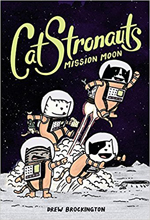 The world is facing an energy crisis like no one, not even the World’s Best Scientist, has ever seen. The problem approaches level cat-astrophe when the feline President acknowledges the situation. No power means more time for catnaps, but things get hairy when cats all over the world have to stop reading because of the darkness! With just sixty days of full power left, the CatStronauts are summoned to build a power plant on the moon. And that just scratches the surface. Major Meowser, Chief Science Officer Pom Pom, Technical Specialist Blanket, and Pilot Waffles face challenges galore as they try to save the world. Brockington’s lively and punny text and cartoon illustrations explore topics like teamwork, self-confidence, and leadership as well as environmental issues.
The world is facing an energy crisis like no one, not even the World’s Best Scientist, has ever seen. The problem approaches level cat-astrophe when the feline President acknowledges the situation. No power means more time for catnaps, but things get hairy when cats all over the world have to stop reading because of the darkness! With just sixty days of full power left, the CatStronauts are summoned to build a power plant on the moon. And that just scratches the surface. Major Meowser, Chief Science Officer Pom Pom, Technical Specialist Blanket, and Pilot Waffles face challenges galore as they try to save the world. Brockington’s lively and punny text and cartoon illustrations explore topics like teamwork, self-confidence, and leadership as well as environmental issues.
—LK
Otherwise Known as Possum. Maria D. Laso. 2017. Scholastic.
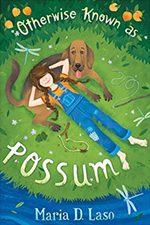 Set in the south in the 1930s, this book tells the story of Possum and her dog, Trav. Possum’s mother has passed away and her father decides to send her to school, despite her mother’s wish that “In a school you learn everything between four walls. I want you to learn the world.” Possum loves to read but resists school, worries that her father is dating the teacher, and finds herself in a battle with the teacher’s pet, whom her best friend Tully may have a crush on. Otherwise Known as Possum is beautifully written, with language that reflects the time and place as well as Possum’s creative thinking. Possum’s love of nature, rebellious attitude, and affection for her family and community make her a likeable character. Although her mom called her LizBetty, Possum fits her much better as she defies gender stereotypes, relies on camaraderie with Trav, and connects with her mom under the peach tree.
Set in the south in the 1930s, this book tells the story of Possum and her dog, Trav. Possum’s mother has passed away and her father decides to send her to school, despite her mother’s wish that “In a school you learn everything between four walls. I want you to learn the world.” Possum loves to read but resists school, worries that her father is dating the teacher, and finds herself in a battle with the teacher’s pet, whom her best friend Tully may have a crush on. Otherwise Known as Possum is beautifully written, with language that reflects the time and place as well as Possum’s creative thinking. Possum’s love of nature, rebellious attitude, and affection for her family and community make her a likeable character. Although her mom called her LizBetty, Possum fits her much better as she defies gender stereotypes, relies on camaraderie with Trav, and connects with her mom under the peach tree.
—LC
A Boy Called Bat. Elana K. Arnold. Ill. Charles Santoso. 2017. Walden Pond/HarperCollins.
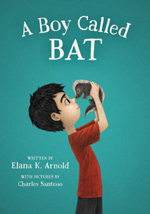 Bixby Alexander Tam’s nickname, Bat, suits him just fine. Bat—a third grader on the autism spectrum—loves animals of all sorts, so when his veterinarian mom brings home a skunk kit, he cares for it and wants to keep it as a pet. There are a lot of reasons why a baby skunk is not a great pet, but in Bat’s case there are additional complications, including the fact that he spends weekends with his father. Bat’s sister Janie is not as excited about the skunk, whom she has named Thor. Bat is determined to be Thor’s caretaker for as long as he can, but he must learn about more than just skunks to prove to his mom that he’s up for the challenge. His desire to take care of Thor helps him to make connections with other people and engage in interactions he would usually avoid. Bat’s interior dialogue and the portrayal of his supportive family make for a realistic story, and the short chapters and black-and-white illustrations add to the overall appeal of this book.
Bixby Alexander Tam’s nickname, Bat, suits him just fine. Bat—a third grader on the autism spectrum—loves animals of all sorts, so when his veterinarian mom brings home a skunk kit, he cares for it and wants to keep it as a pet. There are a lot of reasons why a baby skunk is not a great pet, but in Bat’s case there are additional complications, including the fact that he spends weekends with his father. Bat’s sister Janie is not as excited about the skunk, whom she has named Thor. Bat is determined to be Thor’s caretaker for as long as he can, but he must learn about more than just skunks to prove to his mom that he’s up for the challenge. His desire to take care of Thor helps him to make connections with other people and engage in interactions he would usually avoid. Bat’s interior dialogue and the portrayal of his supportive family make for a realistic story, and the short chapters and black-and-white illustrations add to the overall appeal of this book.
—LC
Ages 12–14
The Unbeatable Squirrel Girl: Squirrel Meets World. Shannon Hale & Dean Hale. Ill. Vitale Mangiatordi. 2017. Marvel.
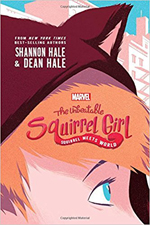 Fourteen-year-old Doreen Green is adjusting to her new school and community after moving from California to New Jersey. She’s anxious to find a new best friend but is struggling to fit in—maybe because of her secret squirrel tail and other squirrel-like traits. Then Doreen makes two new friends: classmate Ana Sofia and Tippy-Toe, her first squirrel friend in her new community. The book alternates with chapters written from Doreen’s and Tippy-Toe’s voices and includes fun footnotes as well as electronic forms of communication. Any superhero story requires an evil villain; in this story readers meet the Micro-Manager, who is out to trap Doreen and destroy the neighborhood. Can Doreen defeat the Micro-Manager? Will her parents stop her from discovering her full superpowers? Is she finally old enough to face the world as Squirrel Girl?
Fourteen-year-old Doreen Green is adjusting to her new school and community after moving from California to New Jersey. She’s anxious to find a new best friend but is struggling to fit in—maybe because of her secret squirrel tail and other squirrel-like traits. Then Doreen makes two new friends: classmate Ana Sofia and Tippy-Toe, her first squirrel friend in her new community. The book alternates with chapters written from Doreen’s and Tippy-Toe’s voices and includes fun footnotes as well as electronic forms of communication. Any superhero story requires an evil villain; in this story readers meet the Micro-Manager, who is out to trap Doreen and destroy the neighborhood. Can Doreen defeat the Micro-Manager? Will her parents stop her from discovering her full superpowers? Is she finally old enough to face the world as Squirrel Girl?
—LC
Storm Horse. Nick Garlick. 2017. Chicken House/Scholastic.
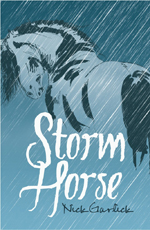 Storm Horse follows the exploits of Flip, an orphaned adolescent boy who’s uprooted to live with his aunt and uncle on their farm on a remote island off the coast of Amsterdam. Flip is lonely until he rescues Storm, a feisty horse who nearly drowns after a boating accident. Finding companionship with his equine friend (also an outsider), Flip navigates the unfamiliar island and family and meets a fellow lost soul in Ghost Girl—a silent, constant presence who is working through her own grief. Garlick’s descriptions of setting and action make this coming-of-age-story a good choice for middle-grade readers.
Storm Horse follows the exploits of Flip, an orphaned adolescent boy who’s uprooted to live with his aunt and uncle on their farm on a remote island off the coast of Amsterdam. Flip is lonely until he rescues Storm, a feisty horse who nearly drowns after a boating accident. Finding companionship with his equine friend (also an outsider), Flip navigates the unfamiliar island and family and meets a fellow lost soul in Ghost Girl—a silent, constant presence who is working through her own grief. Garlick’s descriptions of setting and action make this coming-of-age-story a good choice for middle-grade readers.
—LK
Ages 15+
Frogkisser! Garth Nix. 2017. Scholastic.
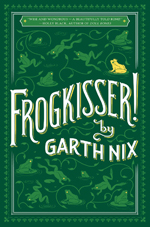 Humorous, clever, wild, and inventive, Garth Nix’s fantasy centers on Princess Anya and her quest to transform a frog prince back to his human form. On the run from her evil stepfather, who wants her dead so that he has a clear line to the throne, Anya encounters various friends, enemies, and perils. With her faithful companion, Ardent (a talking dog), Anya attracts a squad of misfits as she seeks the magic ingredients that will enable her to rescue the prince. Along the way, she learns about her privileged life and the many troubles outside the castle walls. A fun, magical journey that remains lighthearted even as Anya faces grave dangers, including marauding robbers and duplicitous witches, this novel is a welcomed addition to fun-filled and thought-provoking fantasy from a talented author.
Humorous, clever, wild, and inventive, Garth Nix’s fantasy centers on Princess Anya and her quest to transform a frog prince back to his human form. On the run from her evil stepfather, who wants her dead so that he has a clear line to the throne, Anya encounters various friends, enemies, and perils. With her faithful companion, Ardent (a talking dog), Anya attracts a squad of misfits as she seeks the magic ingredients that will enable her to rescue the prince. Along the way, she learns about her privileged life and the many troubles outside the castle walls. A fun, magical journey that remains lighthearted even as Anya faces grave dangers, including marauding robbers and duplicitous witches, this novel is a welcomed addition to fun-filled and thought-provoking fantasy from a talented author.
—LK
Dreaming the Bear. Mimi Thebo. 2017. Wendy Lamb/Random House.
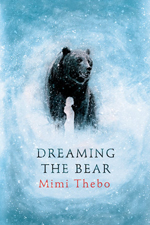 Darcy and her family have moved from England to Yellowstone National Park for her father’s research. Darcy is not adjusting well to the climate and new environment (no Wi-Fi and no nearby shopping). After a bad case of pneumonia, she remains sickly and can’t attend school. Her physical and mental health may be worse than anyone suspects. When Darcy finds and cares for a wounded mother bear. Unfortunately, this relationship results in the bear becoming food-dependent and thus a danger to everyone. Darcy’s brother, Jem, and his best friend, Tony, are the first to recognize the mistake Darcy has made. They must figure out how and when to tell the authorities and if they can trust Darcy’s parents with the truth. As Darcy learns more about bears and about how both humans and bears survive in harsh winter conditions, readers may become as attached to the bear as they are to Darcy.
Darcy and her family have moved from England to Yellowstone National Park for her father’s research. Darcy is not adjusting well to the climate and new environment (no Wi-Fi and no nearby shopping). After a bad case of pneumonia, she remains sickly and can’t attend school. Her physical and mental health may be worse than anyone suspects. When Darcy finds and cares for a wounded mother bear. Unfortunately, this relationship results in the bear becoming food-dependent and thus a danger to everyone. Darcy’s brother, Jem, and his best friend, Tony, are the first to recognize the mistake Darcy has made. They must figure out how and when to tell the authorities and if they can trust Darcy’s parents with the truth. As Darcy learns more about bears and about how both humans and bears survive in harsh winter conditions, readers may become as attached to the bear as they are to Darcy.
—LC
Lesley Colabucci is an associate professor of early, middle, and exceptional education at Millersville University, Millersville, PA. She teaches classes in children’s literature at the graduate and undergraduate level. Leigh Kaliss is the volunteer and outreach Coordinator at Lancaster Public Library in Lancaster, PA.